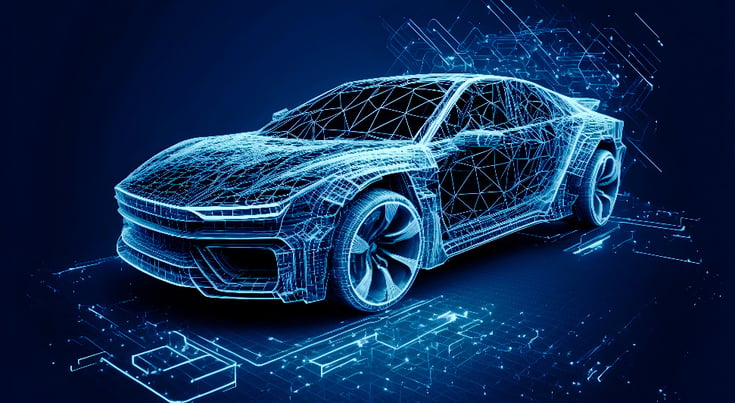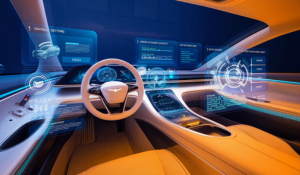Welcome to the dynamic world of automotive cybersecurity, where the rapidly evolving landscape of vehicle technology meets the stringent demands of digital security. In this post, we delve into the critical standards shaping the industry's response to cybersecurity threats.
Central to this discussion are ISO/SAE 21434 and ISO 26262 - two pivotal standards that guide manufacturers in safeguarding modern vehicles against cyber threats while ensuring functional safety. We also explore the role of AUTOSAR in standardizing software architectures, and how international regulations like WP.29 and Regulation No. 155, as well as the NHTSA’s cybersecurity best practices, are defining the future of automotive security.
ISO/SAE 21434: The Cybersecurity Roadmap for Cars
Jointly developed by the International Organization for Standardization (ISO) and the Society for Automotive Engineers (SAE), ISO/SAE 21434 has emerged in recent years as the GPS for automotive cybersecurity.
The standard, specifically tailored for automotive cybersecurity, serves as a comprehensive framework that outlines roles, responsibilities, and common terminology for automotive product development. ISO/SAE 21434 also defines product lifecycle stages with objectives and outcomes, including the Threat Analysis and Risk Assessment (TARA) to evaluate cybersecurity risks within a product.
A comprehensive framework designed to face the increasingly unique and complex challenges presented by the integration of connected devices within CASE vehicles, ISO/SAE 21434 stresses the importance of incorporating cybersecurity into each phase of designing and producing today's connected vehicles. By setting these guidelines, the standard aims to ensure that vehicles are not only functionally efficient but also secure from cyber threats, safeguarding the data and privacy of users and the integrity of vehicle systems.
The Impact and Implementation of ISO/SAE 21434 in the Automotive Industry
The implementation of ISO/SAE 21434 represents a crucial step towards enhancing the overall cybersecurity posture of vehicles. Requiring automotive manufacturers and suppliers to adopt a systematic approach to cybersecurity, ISO/SAE 21434 mandates the:
- Establishment of cybersecurity goals
- Execution of comprehensive risk analyses
- Implementation of effective risk mitigation strategies
The standard covers several areas of automotive cybersecurity such as threat modeling, incident response, and the management of cybersecurity in the supply chain.
ISO/SAE 21434 also underscores the need for continuous monitoring and updating of cybersecurity measures to respond to new and evolving threats. By adhering to the guidelines set forth in ISO/SAE 21434, automotive companies can not only minimize the risk of cyberattacks but also build consumer trust in their products.
As the automotive industry continues to evolve with advancements in connected and autonomous vehicle technologies, the role of standards like ISO/SAE 21434 becomes increasingly significant in ensuring that cybersecurity is an integral part of the innovation process.
ISO 26262: Functional Safety for Vehicles
ISO 26262, titled "Road Vehicles – Functional Safety," is a critical standard focusing on the functional safety of electrical and electronic systems in road vehicles. Originating from IEC 61508, which addresses the functional safety of electrical/electronic/programmable electronic safety-related systems, ISO 26262 adapts these principles specifically for the automotive sector.
The standard delves into ensuring that automotive systems, including their electrical and electronic components as well as mechanical subsystems, are designed, developed, implemented, and operated with the highest safety levels in mind.
ISO 26262 is designed to address hazards potentially caused by malfunctioning behavior of vehicle electronic and electrical systems. It encompasses the entire automotive safety lifecycle, covering stages from management, development, and production, to operation, service, and even decommissioning.
ISO 26262 outlines activities across these lifecycle phases, supporting the tailoring of necessary actions to ensure safety at each step. The process includes a wide array of tasks such as risk assessment, system development, and hardware and software design, emphasizing the importance of safety in both the production and operational phases of vehicle systems.
At the heart of ISO 26262 is a risk-based approach, inherited from IEC 61508, focusing on qualitatively assessing the risk of hazardous operational situations. It defines safety measures to avoid or control systematic failures and to detect, control, or mitigate the effects of random hardware failures. The standard introduces Automotive Safety Integrity Levels (ASILs), a risk classification scheme that plays a pivotal role in determining the necessary safety requirements for minimizing and achieving an acceptable level of residual risk.
ISO 26262 also sets forth requirements for validation and confirmation measures, ensuring that the safety levels achieved are both sufficient and acceptable. This includes detailed guidelines for the entire development process, including activities such as requirements specification, design, implementation, integration, verification, validation, and configuration. By providing these comprehensive guidelines and a methodical approach to safety, ISO 26262 plays an essential role in reducing the likelihood of failures and enhancing the overall safety of vehicles, ensuring that both the systems and their users are protected from potential hazards on the road.
The Role and Impact of ISO 26262 in the Automotive Industry
ISO 26262 guides automotive manufacturers and suppliers towards achieving high safety standards. One of the key concepts introduced by this standard is the Automotive Safety Integrity Level (ASIL), which is a risk classification scheme used to determine the necessary safety requirements for mitigating specific risks. The ASIL categories, ranging from A (lowest) to D (highest), are assigned based on the severity, exposure, and controllability of potential hazards.
This risk-based approach allows for a systematic assessment and management of safety risks, ensuring that more stringent measures are applied to higher-risk scenarios. As vehicles become increasingly complex with advanced driver assistance systems (ADAS) and autonomous driving capabilities, ISO 26262 becomes more critical in ensuring that these sophisticated technologies do not compromise vehicle safety.
The standard emphasizes not only the prevention of system failures but also ensuring that vehicles can safely manage failures when they occur. In this way, ISO 26262 is a cornerstone in the pursuit of safer roads and vehicles, aligning with the industry's commitment to reducing accidents and enhancing passenger safety.
Secure Development with AUTOSAR
AUTOSAR stands for AUTomotive Open System ARchitecture, an initiative that represents a pivotal shift in the way automotive software is developed and integrated. Established as a worldwide partnership among automakers, suppliers, and technology companies, AUTOSAR aims to standardize the software architecture for vehicle electronic control units (ECUs).
AUTOSAR addresses the increasing complexity and variety of software in modern vehicles, facilitating better software management, scalability, and interoperability. At its core, AUTOSAR provides a layered software architecture that allows for a clear separation of application software from the underlying hardware. This enables software components to be developed and tested independently from hardware, offering greater flexibility and efficiency.
By standardizing how software modules interact within a vehicle's system, AUTOSAR simplifies the integration process, enabling easier updates and maintenance, and paving the way for more innovative features in vehicles.
The Impact and Implementation of AUTOSAR in the Automotive Industry
AUTOSAR's impact on the automotive industry is significant, particularly as vehicles evolve with more complex electronic systems and connectivity features. The platform supports a range of applications, from basic vehicle functions to advanced driver assistance systems (ADAS) and autonomous driving technologies. One of the key benefits of AUTOSAR is its ability to facilitate the integration of software from different vendors, reducing development times and costs. This is particularly crucial in an industry where collaboration among multiple suppliers and manufacturers is common.
AUTOSAR also plays an essential role in enhancing the reliability and safety of automotive software, as the standardized architecture allows for rigorous testing and validation of software components. As the industry moves towards electric vehicles and increased autonomy, the role of AUTOSAR becomes even more critical in managing the software-driven aspects of these technologies. By providing a robust and flexible software architecture, AUTOSAR not only streamlines development processes but also helps ensure that the software within vehicles is secure, reliable, and up to date with the latest technological advancements.
WP.29 and Regulation No. 155
The World Forum for Harmonization of Vehicle Regulations, commonly known as WP.29, is a pivotal global body within the institutional framework of the United Nations Economic Commission for Europe (UNECE). WP.29 plays a crucial role in shaping international standards and regulations for motor vehicles, focusing on ensuring safety, environmental protection, and energy efficiency.
The forum is a unique platform that brings together representatives from countries around the world, including major vehicle-producing nations, to collaborate on the development of globally harmonized vehicle regulations. These regulations are designed to facilitate international trade while upholding high standards of safety and environmental sustainability.
WP.29 oversees the development and implementation of a range of vehicle regulations, covering aspects from vehicle construction and performance to the approval of vehicle components. The forum’s work is instrumental in creating a unified and coherent set of regulations that can be adopted by countries globally, thus reducing barriers to international trade in the automotive sector while ensuring that vehicles meet stringent safety and environmental standards.
Regulation No. 155: Strengthening Automotive Cybersecurity
One of the significant regulations developed under WP.29 is UN Regulation No. 155, which specifically addresses the cybersecurity of road vehicles. This regulation marks a critical advancement in automotive standards, reflecting the growing importance of cybersecurity in the era of connected and autonomous vehicles.
Regulation No. 155 mandates that vehicle manufacturers establish and maintain a comprehensive Cybersecurity Management System (CSMS) to protect vehicles against cyber threats throughout their entire lifecycle. This includes conducting thorough threat analysis and risk assessments during vehicle development, as well as implementing strategies to mitigate identified cybersecurity risks.
The regulation also requires manufacturers to have processes in place for monitoring, responding to, and learning from cybersecurity events. This ensures a proactive approach to vehicle cybersecurity, enabling manufacturers to adapt and respond to evolving cyber threats. The introduction of Regulation No. 155 under WP.29 underscores the global recognition of the need for stringent cybersecurity measures in the automotive industry. It sets a precedent for other countries and regions to follow, potentially leading to more unified global standards for automotive cybersecurity.
Overview of NHTSA Cybersecurity Best Practices
The National Highway Traffic Safety Administration (NHTSA), recognizing the growing cybersecurity challenges in the automotive industry, has formulated a set of best practices aimed at enhancing the cybersecurity of modern vehicles. These guidelines are a response to the increasing complexity and connectivity of today’s cars, which make them more susceptible to cyber threats. The NHTSA’s best practices focus on encouraging manufacturers to integrate robust cybersecurity measures throughout the entire lifecycle of a vehicle. This encompasses the design, development, production, operation, and maintenance phases.
The core elements of these best practices include risk assessment and management, where manufacturers are urged to identify potential cybersecurity threats and vulnerabilities, and implement strategies to mitigate these risks. The guidelines emphasize a layered approach to security, incorporating a range of protective measures to defend against potential cyber-attacks and to ensure the safety and privacy of vehicle users.
Implementation and Impact of the NHTSA Guidelines
Implementing these best practices involves a proactive and dynamic approach to vehicle cybersecurity. The NHTSA advocates for the continuous monitoring and testing of cybersecurity measures to adapt to evolving threats. This includes regular updates and patches to address new vulnerabilities, along with incident response and recovery plans to quickly respond to and recover from cyber incidents.
The guidelines also stress the importance of collaboration and information sharing among industry stakeholders, including manufacturers, suppliers, cybersecurity researchers, and government agencies. This collaborative approach is crucial in developing a comprehensive and unified response to the cybersecurity challenges faced by the automotive industry.
By adopting these best practices, manufacturers can not only enhance the cybersecurity resilience of their vehicles but also build greater consumer trust in their products. As vehicles continue to advance in terms of technology and connectivity, adhering to the NHTSA's cybersecurity best practices becomes increasingly critical in ensuring the safety and security of modern vehicles.
As we navigate the intricate world of automotive cybersecurity and safety, it's evident that standards like ISO/SAE 21434 and ISO 26262 are more than just guidelines; they are the foundational pillars ensuring the safety and security of modern vehicles. Alongside AUTOSAR's role in harmonizing software architecture and the global regulatory impact of WP.29 and Regulation No. 155, these standards collectively represent a comprehensive approach to tackling the multifaceted challenges of automotive cybersecurity. The NHTSA's best practices further emphasize the industry's commitment to a proactive and collaborative approach in securing vehicles.
Embracing these standards is crucial for manufacturers to stay ahead of emerging threats, ensuring that the vehicles of today and tomorrow are not only advanced in technology but also resilient in the face of cybersecurity challenges. As the automotive industry continues its journey towards an increasingly connected and autonomous future, adhering to these rigorous standards and practices is paramount in fostering a secure, trustworthy automotive landscape for all.
Subscribe to Our Blog
Get the latest posts delivered straight to your inbox weekly.
Share this
You May Also Like
These Related Stories

Exploring Standards and Regulations for Automotive Cybersecurity

Exploring the Dept. of Commerce’s Proposed Rule for Connected Vehicles



